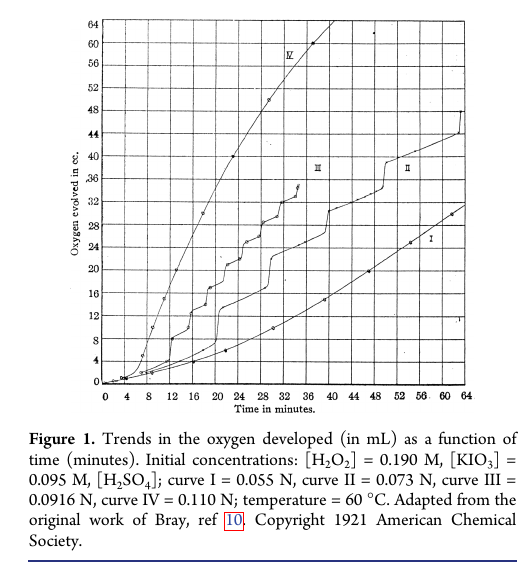I am trying to complete the Bray-Liebhafsky reaction in the lab so I can use it in the future for demonstrations.
The above Wikipedia link quote:
A fundamental property of this system is that hydrogen peroxide has a redox potential which enables the simultaneous oxidation of iodine to iodate:
$$\ce{5 H2O2 + I2 -> 2 IO3− + 2 H+ + 4 H2O}$$
and the reduction of iodate back to iodine:
$$\ce{5 H2O2 + 2 IO3- + 2 H+ -> I2 + 5 O2 + 6 H2O}$$
Between these two reactions the system oscillates causing a concentration jump of the iodide and the oxygen production. The net reaction is:
$$\ce{2 H2O2 -> 2 H2O + O2}$$
necessitating a catalyst and $\ce{IO3-}$.
I am trying to set it up in a very simple manner, in a beaker with a stirrer and hotplate. From what I have seen from reading numerous papers it should just need a heated solution of sulfuric acid and potassium iodate and then be mixed with another solution of hydrogen peroxide and the reaction should proceed.
However, in my attempts so far I have been unable to get the desired colour changes. How do you run this reaction?
There seems to be lots of information on how to run both the BZ and BR oscillating reactions but I have been unsuccessful in finding meaningful information for this one.
I am wondering if I need an indicator to be able to visibly see the oscillations?
UPDATE: Current experimental procedure. a 50 mL solution of 0.125M potassium iodate and 0.24M sulfuric acid was made and heated to 65 degrees in an oil bath. After half an hour 1.3 mL of 30% w/w hydrogen peroxide was added.
I have also tried other varying concentrations of iodine/sulfuric acid and hydrogen peroxide with no success as yet also I have done this at temperatures of 25, 50 and 60 degrees.


